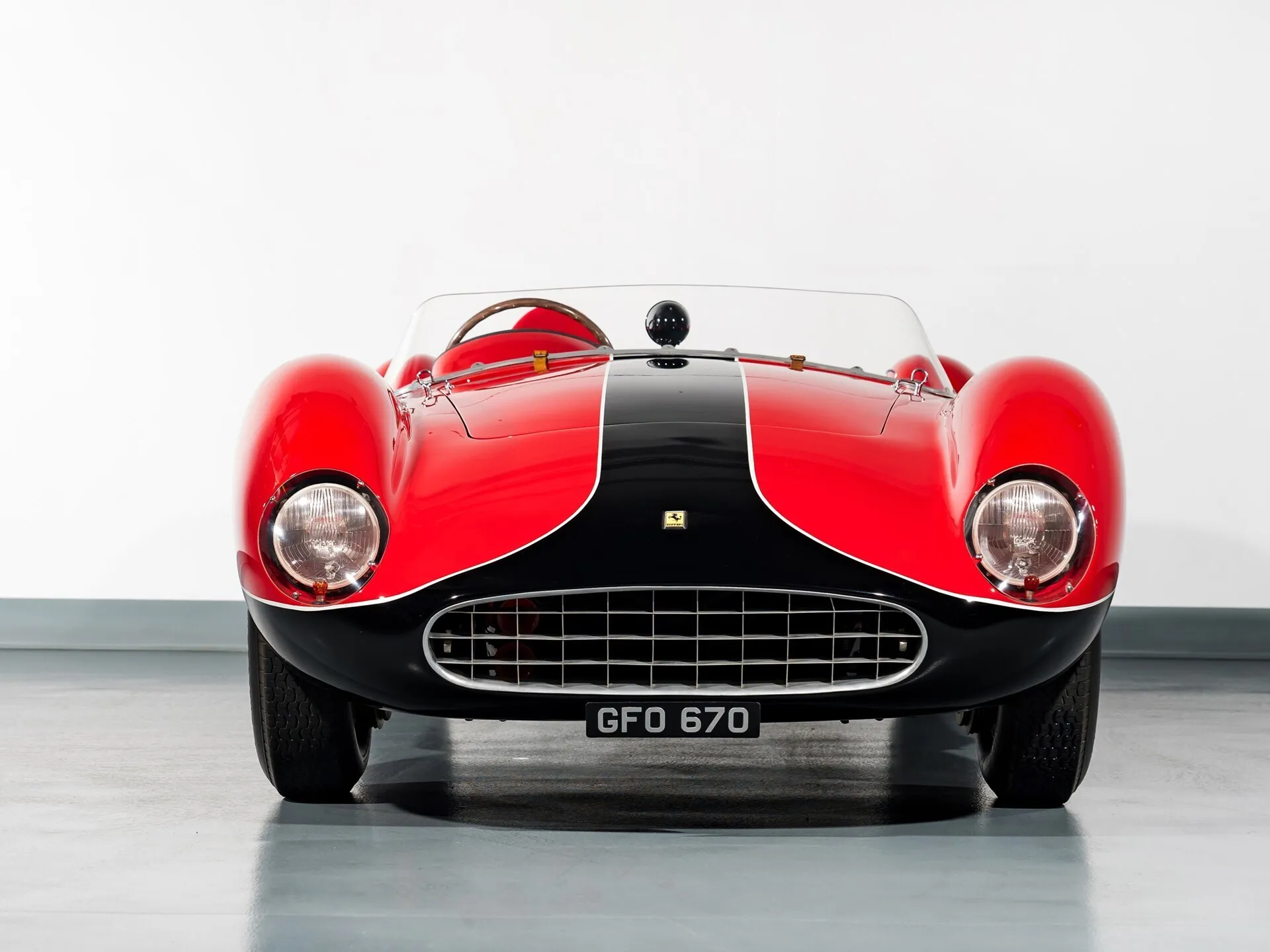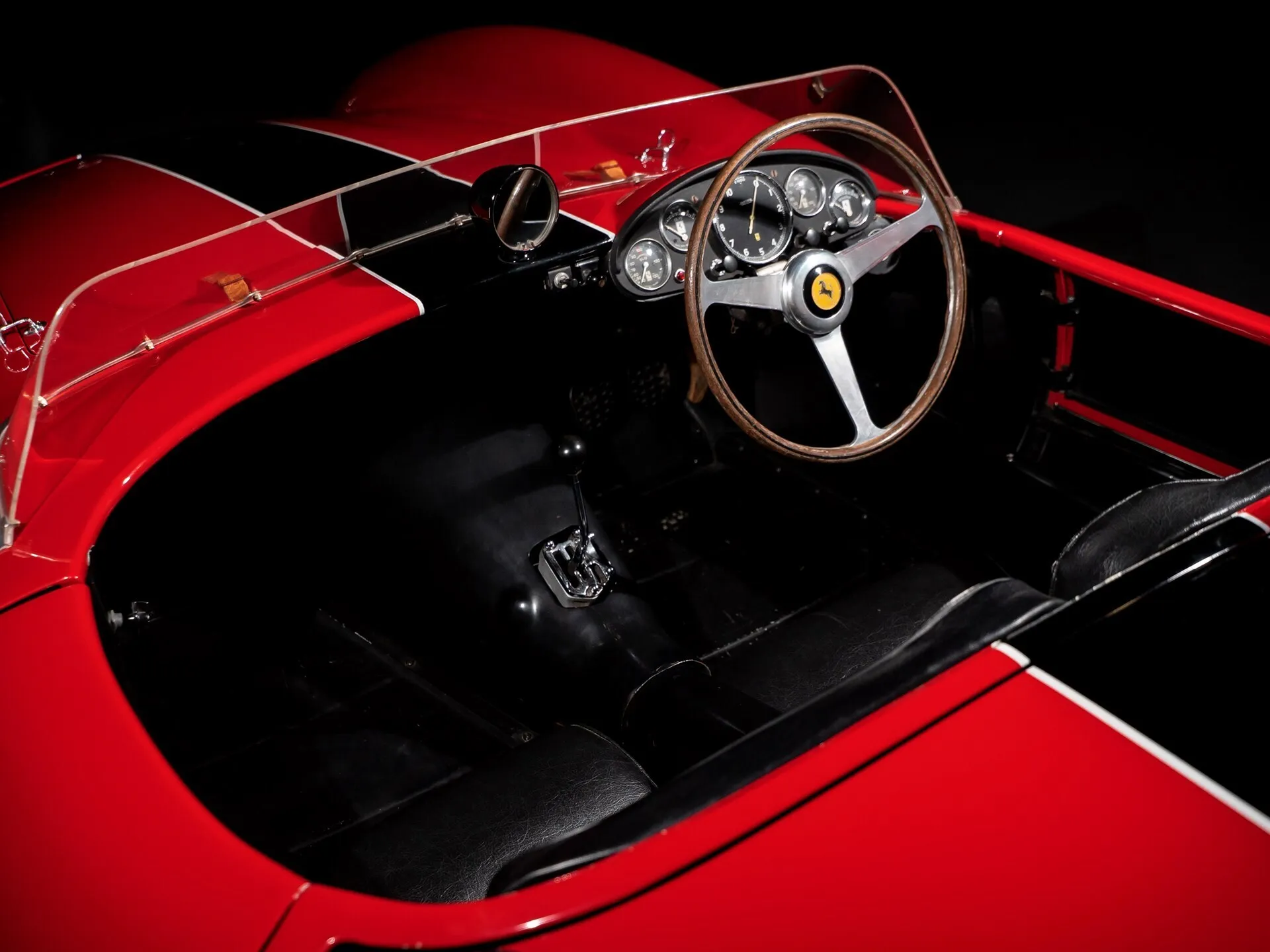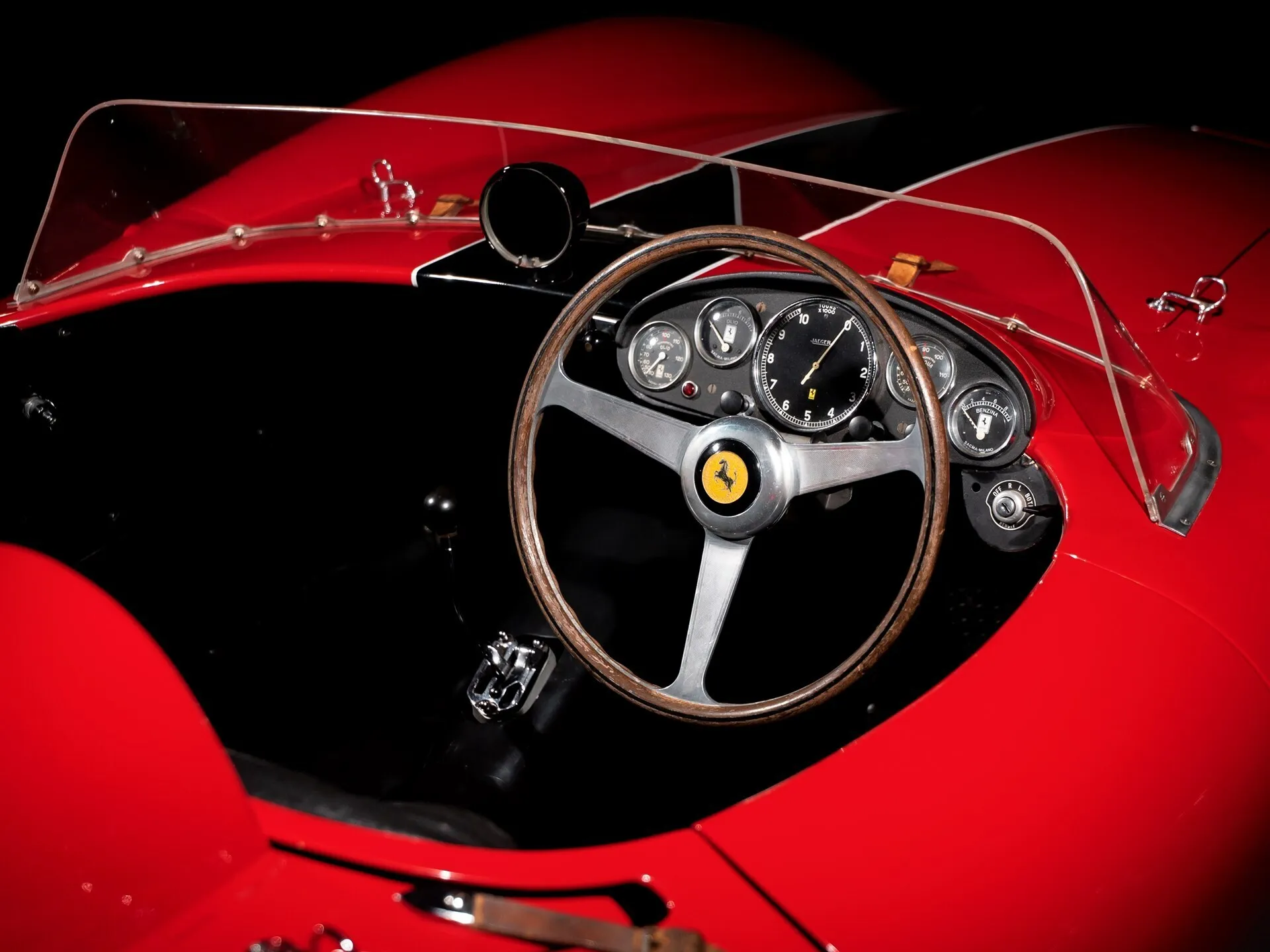RM Sotheby’s | 1957 Ferrari 500 TRC Spider by Scaglietti
Ofrecido de la colección Oscar Davis.
- El 18 de 19 ejemplos construidos; ampliamente considerado el más bello de los diseños de Testa Rossa
- Corrió en las 24 Horas de Le Mans de 1957 por Richie Ginther y François Picard
- Conducido a 12 victorias generales o de clase por la leyenda de las carreras Gaston Andrey en el camino hacia los campeonatos SCCA E-Modified de 1958 y 1959
- Carrera de carreras excepcionalmente larga y exitosa en al menos 30 largadas entre 1957 y 1963, con 18 podios
- Actualmente equipado con motor de números coincidentes
- Altamente elegible para los eventos más exclusivos del mundo en carreras, rallies y concursos, incluidos Mille Miglia Storica y Le Mans Classic

Ferrari 500 TRC Spider de 1957 por Scaglietti Motorcar Studios ©2022 Cortesía de RM Sotheby’s
COMIENZA LA LEYENDA DE TESTA ROSSA
Aunque es mejor recordado por diseñar el motor V-12 de bloque largo que Ferrari llevó hasta la victoria en las 24 Horas de Le Mans de 1954, el ingeniero Aurelio Lampredi también fue responsable de un motor de cuatro cilindros muy exitoso. El pilar de los campeonatos mundiales de pilotos de Fórmula 2 de 1952 y 1953 de Ferrari (los años durante los cuales la Fórmula 1 se canceló esencialmente debido a la falta de competencia), este motor pronto se transpuso a las carreras de autos deportivos, impulsando el 500 Mondial y el 750 Modelos de Monza a numerosas victorias.
Las fortalezas del motor fueron particularmente evidentes en circuitos sinuosos más cortos, donde el motor liviano y de altas revoluciones podía impulsar las curvas, a menudo dejando a los competidores con motor V-12 en el polvo.

Ferrari 500 TRC Spider de 1957 por Scaglietti Motorcar Studios ©2022 Cortesía de RM Sotheby’s
Después de la salida de Lampredi en 1955, un nuevo equipo de ingeniería dirigido por el ex-maestro de Alfa Romeo Vittorio Jano se encargó de desarrollar aún más el motor de cuatro cilindros, y su trabajo contó con el auspicio de la instalación de un nuevo bloque de cilindros con acabado en rojo brillante. pintar. Esto marcó el inicio del poderoso Testa Rossa, un modelo que finalmente estaría equipado con un V-12 de cabeza roja y se convertiría posiblemente en la serie de prototipos de carreras deportivas más legendaria de todos los tiempos.

Ferrari 500 TRC Spider de 1957 por Scaglietti Motorcar Studios ©2022 Cortesía de RM Sotheby’s
El 500 TR hizo su debut en el Gran Premio de Senegal con el equipo de carreras Ecurie Francorchamps de Jacques Swaters, logrando un éxito inmediato con un 1° en su clase. La mayoría de los ejemplos posteriores fueron carrozados por Scaglietti y destinados a los principales clientes privados de Ferrari, mientras que un pequeño puñado se actualizó a motores de 2.5 litros y Touring los carrozó para usarlos como autos Scuderia Ferrari Works. Fueron dos de estos últimos ejemplos los que lograron el primer gran éxito internacional del modelo cuando terminaron primero y tercero en el Gran Premio Supercortemaggiore de 1956 en Monza. El éxito continuó a lo largo de 1956 con el nuevo “Red Head” logrando más de 30 victorias generales y de clase en América del Norte y Europa.
Para 1957, el 500 TR se actualizó para cumplir con las últimas regulaciones del Apéndice C de la FIA, y el modelo pasó a llamarse 500 TRC. Tres pulgadas más bajo que su predecesor, el TRC utilizó una caja de cambios convencional de cuatro velocidades montada en el motor y un eje trasero vivo, evitando la parte trasera más pesada de De Dion empleada en el 500 Mondial. Con bielas y conjunto de cigüeñal más fuertes, y un volante de inercia más ligero, el motor tipo 131C fue alimentado por dos carburadores Weber 40 DCOA/3, combinándose para desarrollar 190 caballos de fuerza y alcanzar una velocidad máxima potencial de 153 mph. Desarrollado exclusivamente para clientes de carreras privadas, el 500 TRC obtuvo victorias en su clase en las 24 Horas de Le Mans, la Mille Miglia, las 12 Horas de Sebring y los 1000 KM de Nürburgring.
El 500 TRC se construyó en una cantidad exclusiva de solo 19 ejemplares, y fue el último modelo de cuatro cilindros que produjo Ferrari. Por supuesto, con su cuerpo abierto Scaglietti sensual y su motor pelirrojo, resultó ser solo la salva inicial de la leyenda de Testa Rossa, pero fue un primer capítulo memorable.

Ferrari 500 TRC Spider de 1957 por Scaglietti Motorcar Studios ©2022 Cortesía de RM Sotheby’s
UNA ‘CABEZA ROJA’ GANADORA
En campaña con numerosas victorias por una alineación de pilotos de carreras de luminarias, este hermoso 500 TRC es un ejemplo muy deseable de los primeros Testa Rossa. Colocado al final de la producción, el 0706 MDTR es el penúltimo automóvil construido y en abril de 1957 la fábrica lo prestó a François Picard, quien volvió a pintar el automóvil en azul francés y corrió bajo la bandera de su Ecurie. Los Amigos. Después de obtener tres victorias en su clase hasta principios de junio, incluida la quinta en la general en el Gran Premio de Portugal, Picard se asoció con la estrella en ascenso Richie Ginther para correr las 24 Horas de Le Mans. A pesar de mostrar una promesa temprana en la carrera, el TRC se retiró luego de una falla en la bomba de agua.
A fines de 1957, el Ferrari se vendió a través de Luigi Chinetti a Mike Garber de Hamden, Connecticut, el patrocinador del legendario piloto de carreras nacido en Suiza, Gaston “Gus” Andrey. Habiendo emigrado a los Estados Unidos, Andrey disfrutó de una carrera muy exitosa que incluyó cuatro campeonatos SCCA y dos campeonatos Trans-Am, conduciendo para NART de Ferrari, Maserati y Alfa Romeo, entre otros.
Todavía terminado con su librea azul de Le Mans, Andrey condujo por primera vez el hermoso 500 TRC en la Nassau Bahamas Speed Week en diciembre de 1957. Andrey no pudo terminar el evento del Tourist Trophy pero volvió fuerte con un segundo lugar en su clase en la carrera preliminar del Governor’s Trophy y un respetable quinto lugar en la clase en la reñida carrera del Trofeo Nassau. Después de Nassau, el automóvil permaneció en el sureste y Mike Garber lo inscribió en las 12 Horas de Sebring de 1958. Conducido por Andrey, Bill Loyd y, durante un breve período, el gran Dan Gurney, el automóvil funcionó bien hasta la vuelta 125, cuando sufrió una falla en el cojinete del eje trasero.
Siguiendo a Sebring, el automóvil se repintó en un esquema de dos tonos de blanco sobre una parte inferior de la carrocería roja, una franja roja y emblemas suizos en cada lado, en homenaje a la herencia suiza de Andrey. Andrey condujo el 0706 MDTR en una serie de carreras hasta 1959, lo que le valió los campeonatos E-Modified de la SCCA en 1958 y 1959. Casi siempre entre los 10 primeros clasificados, el auto logró una victoria general en Lime Rock en abril de 1958 y un victoria de su clase en la President’s Cup de 1958 en Marlboro, Maryland. También ganó su clase en Bridgehampton en junio de 1958, Virginia International Raceway en octubre de 1958, Thompson en mayo de 1959 y Lime Rock en julio de 1959.
El éxito de Ferrari provocó una buena cantidad de cobertura en la prensa automovilística, incluido un artículo en la edición de octubre de 1959 de Road & Track, y el estado del automóvil de portada para la edición de enero de 1960 de Sports Car Graphic. A principios de 1960, Andrey puso a la venta el TRC y, durante las siguientes dos décadas, pasó por una cadena documentada de propietarios en todo Estados Unidos.
A principios de la década de 1960, mientras Henry Hironaka lo conducía en una escuela de carreras, el motor original de 2 litros número 0706 MDTR dejó caer una válvula y se retiró del automóvil. Durante un tiempo, el 0706 MDTR, al igual que muchos autos de carreras Ferrari usados de la época, tenía instalado un motor Ford 289 V-8 para mantenerlo operativo. Posteriormente, se retiró el motor Ford y se instaló un nuevo motor de 2 litros, estampado con el número 0582 LM.
En mayo de 1980, Stanley Nowak encontró el motor 0706 MDTR original embalado en el almacén de Luigi Chinetti, y pronto se lo vendió a Derek Lees en Birmingham, Inglaterra, quien lo instaló en la restauración de un 500 TR, número de chasis 0640 MDTR.

Ferrari 500 TRC Spider de 1957 por Scaglietti Motorcar Studios ©2022 Cortesía de RM Sotheby’s
UNA VUELTA AL CIRCUITO
En 1984, el 500 TRC fue comprado por el conde Hubertus von Dönhoff en Alemania, y durante los siguientes 10 años ingresó al automóvil dos veces en Mille Miglia Storica y tres veces en el AvD-Oldtimer Grand Prix en Nürburgring. Para 1995, el Ferrari estaba de regreso en los EE. UU. y se exhibió con orgullo en el Cavallino Classic de 1995, ganando la Coppa per Quattro Cilindri al mejor Ferrari de cuatro cilindros.
Posteriormente, el 500 TRC se vendió en septiembre de 1998 a Roger Willbanks, Sr., un respetado coleccionista con sede en Colorado que presentó el automóvil en el Meadow Brook Concours d’Elegance de 2001, el Amelia Island Concours d’Elegance de 2003 y el Pebble Beach de 2005. Concours d´Elegance. Tras la venta a un coleccionista con sede en Nueva York en 2006, el coche se mostró en el Concurso de Elegancia de Reading de 2007, donde ganó el Premio Scaglietti. En 2014, este 500 TRC fue adquirido por Oscar Davis y, lo que es más importante, el automóvil se reunió con el motor de coincidencia de números número 0706 MDTR, que se reinstaló recientemente en preparación para la oferta actual del automóvil. Su motor de repuesto, número 0582 LM, acompaña a la venta.

Ferrari 500 TRC Spider de 1957 por Scaglietti Motorcar Studios ©2022 Cortesía de RM Sotheby’s
Esta sensacional araña, que ahora se ofrece de la Colección Oscar Davis, sigue beneficiándose de una restauración más antigua. Reclama un uso importante en la competencia, ya que fue conducido por Richie Ginther en las 24 Horas de Le Mans y por Gaston Andrey en las 12 Horas de Sebring, que también formaron el componente principal de sus campeonatos SCCA de 1958 y 1959.
Simplemente inspirador en su carrocería Scaglietti rojo sobre negro amenazante, este llamativo 500 TRC sería un gran participante en importantes eventos de marca o se puede disfrutar en reuniones de carreras clásicas como Mille Miglia Storica, Le Mans Classic o Monterey Historics. , además de los mejores concursos de elegancia del mundo. La carrocería voluptuosa declara instantáneamente la posición del automóvil en la evolución de una célebre leyenda, esa obra maestra de carreras de autos deportivos conocida para siempre por dos palabras: Testa Rossa.





















